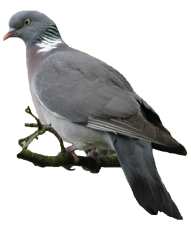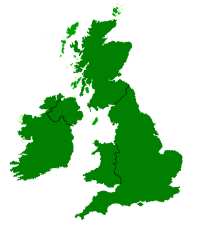|
Photography
|
Woodpigeon Plate | ||||
|
|
|||||
| Distinguishing Features |  |
||||
| Height 40cm (16in), Blue/grey plumage on head/back and wings with white cresecent on wing. Chest is a reddy/purple colour with white and green markings on the neck and black band on tail. Sexes alike. | |||||
| Food | |||||
| Mainly vegetarian including brassicas, cabbage, swede, also berrys, peas, seeds, wheat, barley. Insects, snails and worms will be taken too. | |||||
| (Columbidae)
columba palumbus |
|||||
|
|
|||||
 |
Nesting | ||||
| Between July - September. Clutch of 1 to 2 eggs, white in colour. Incubation appx 17days. Eggs tended by both parents. Two broods. | |||||
| Habitat | |||||
|
Farmland with trees, copses, woods. Increasingly found in town and city parks and woodlands. |
|||||
|
The darker green on the map above indicates
where you are most likely to see a Woodpigeon.
|
|||||
|
|
|||||
| Other information | |||||
|
The Woodpigeon is so common on farmland and woodlands that pest control is an unfortunate part of this birds life. Farmland is a regular target for feeding. The nest which is constructed of twigs, is a flimsy construction and is often see-through which reveals a view of the eggs from the ground. The Woodpigeon has the ability to produce a pigeon milk from their crop which they feed to their young much like a mammel would do. Although they are quite shy around farm and woodland, they can become relativly tame in urbanised areas like towns and city. |
|||||
| [Home] [News] [Gallery] [Birds] [Discover] [About] [Contact] [Members] | |||||